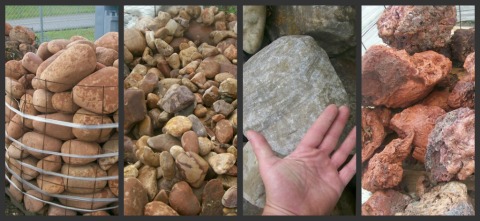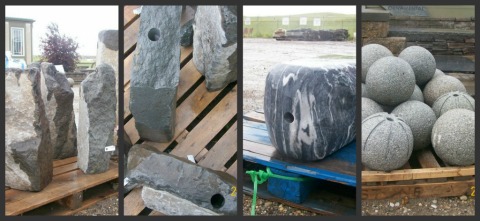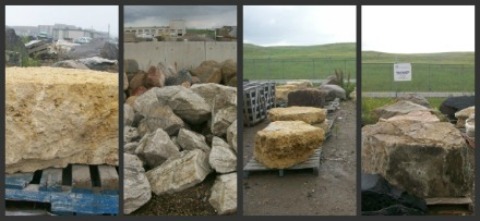F. Buying Rock
Buying rock is the sixth article in our estimating landscape materials series, and if you just joined us, here is what we have covered so far:
Manufactured Materials: Bricks, and blocks for garden and retaining walls. Bricks and paver stones for patios, walkways, and path's. Related products like paver sand, jointing sand, sealers and edging materials.
Natural Products: Decorative rocks, sand and gravel for building sub-bases.
If you wish to view one of these other materials covered in this series, please see our links at the bottom of this page.
Buying and estimating for larger natural stone products
Now we are going to look at more natural products and a few specialty products. Starting in this article with bubblers, large feature boulders, and rocks. Flagstone and landscaping steps will be in the next article.
Buying rock for water features like big walls, backyard waterfalls, landscaping fountains, and bubblers is a little different than manufactured products or gravel. They are more difficult to estimate, so let's look at a few different products and how they can be sold.
Small boulders and mixed rocks with volcanic rock on far right.
Photo compliments of Ornamental Stone.
River rocks and small boulders are usually purchased by the pound when they are caged, and by the cubic yard when they are sold loosely from bulk bins. These are quite often used in hillside rock gardens, waterfalls, and other water features.
Larger volcanic rocks (shown on right above) are usually sold by
the yard. They are not as dense in composition so pricing them by the
weight is more difficult. They are not as common in most areas of the
world, and can be quite expensive according to your proximity to that
type of geology.
Bubblers
The "Bubbler" concept has been around for over 100 years, and was first introduced as simple drinking fountains for schools and playgrounds. This concept of forcing water through a line with a pump has since been adopted in the landscaping industry, to make attractive and soothing continuous running fountains.
Bubblers and granite balls.
Drilled stone bubblers (as shown above), are fast becoming one of the more popular water feature ideas. They are easy to install, and are very low maintenance.
Bubblers are priced to reflect the stone, as well as the effort
that goes into drilling the hole. Specialty equipment, drill bits, and
saw blades used in stone yards are very expensive. These blades and bits
have to cut through some very hard stone.
Larger Feature Rocks
Feature boulders and feature rocks like granite, limestone, and quartz are usually sold by the pound. They can also be priced by the size as well. They quite often cost more than people think and here is why.
There is a substantial amount of time and effort involved in the
process. We have to factor in equipment, fuel, and labor when delivering
these larger rocks to the landscaping yard. Most of us don't have the
capability or equipment to do this ourselves. For those of you that do,
you can save yourself a great deal of money collecting your own rocks.
Estimating needs for Rock
Large feature boulders don't require a formula for estimating how much you need like flagstone. They are placement features and picked out like pumpkins. Select the biggest, nicest one you can that will fit into the desired location. Just try to keep it in proportion with other features in your yard.
As for river rock or other anything sold by the cubic yard, you will use the same formula as other gravel or fill in type materials.
First calculate the area that needs to be filled in. Length times width times depth. That will give you the cubic feet of the area. Convert this to cubic yards when the material is sold in this manner. Do this by dividing by 27
Example: area that is 10 ft. wide, 10 ft. long, 6 inches deep.
10x10x.5= 50 cubic ft. Divided by 27= 1.85 cubic yards required.
This will give you the amount you will need in cubic yards. You will probably have to round up so you don't run short. (2 yards in the above example). Most suppliers have full yard and half yard buckets.
Always remember that any materials that you are compacting, will require an additional 5 to 20% to account for compaction. It will depend on what equipment you are using to compact with. If you don't order more, you will find yourself short on materials. In the above example you may have to order an additional half yard to account for compaction.
Need help? Use our volume conversion calculator to convert from cubic feet to cubic yards.
For more information on estimating go to our Quick Landscaping Estimating Reference for formulas and examples.
UnitConversion.org - online unit converter of length, weight, volume, area, and more.If you are building a wall, skip forward to our next section for natural stone wall estimating formulas. It will be a little more helpful for you.
It is pretty straight forward dealing with these natural products. In the next section we are going to talk about natural flagstone, steps, and wall materials.
So let's go look at Buying Flagstone.
______________________________________
Introduction Estimating Materials
Table of Contents: Landscaping Yards
A. Landscaping Yards Introduction
C. Patio Bricks and Paver Stones
F. Buying Rock
H. Other Landscaping Materials
I. Quick Landscaping Estimating Reference
Table of Contents: Buying Soil
______________________________________
Return to the Estimating Materials Introduction
Go to the Dream Yard Home Page
Check out our time and money saving e-book
How to avoid the biggest mistakes made by DIYers, designers, and landscaping companies.
Visitor
Favorites
Giggles 'n' Thoughts








